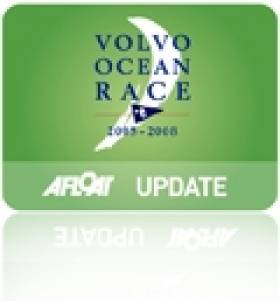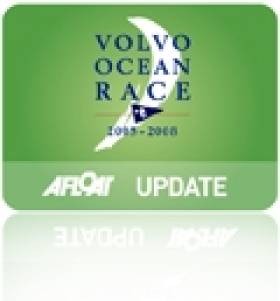Displaying items by tag: One Design
The Resurgent Glen Keelboat & Why Local One Design Sailing Classes Have Never Been More Relevant
The cherished local One-Design classes of Ireland have never been more relevant than they are now, in these crazy times of soaring-graph numbers when local is good. The expectation of staying local, while making do with fairly modest socialising and sporting ambitions, is proving to be the ideal way to avoid having to go through more travel hassle than the eventually-achieved broad-scope socializing event or sporting competition is worth.
Admittedly there are those for whom "staying local" in Ireland has now come to encompass the entire island. And beyond that there are those who have suddenly rediscovered their dormant sense of being European, which apparently can only be assuaged by a highly-monitored endlessly bothersome journey to some southern sun-spot.
But with summer settling in over Ireland for the next few days at least, local sailing is in the ascendant. And the historic neighbourhood classes are blossoming, with the Water Wags in Dun Laoghaire (originally founded 1887) on the cusp of achieving their first-ever turnout of forty boats racing at once, while across Dublin Bay the 1898-founded Howth 17s are pushing towards a cracking turnout of 20 boats regularly racing.
Meanwhile up on Strangford Lough the handsome 28ft 6ins sloops of the River Class are celebrating their Centenary in style with all of the 12 boats ever built to the design currently in full commission, and a really handsome, informative and well-illustrated history of the class by James Nixon has been published to help the celebrations along (and yes, he is the brother, but the book really is super).
 Graham Smyth's Enler, Strangford Lough River Class Centenary Champion. Photo: W M Nixon
Graham Smyth's Enler, Strangford Lough River Class Centenary Champion. Photo: W M Nixon
In fact, Strangford Lough, where the majority of all boats still lie to swinging moorings, is ideal for the classic local and inevitably engine-less classes, as such craft never seem comfortable in the confines of a marina berth even if skilled crews have long since learned how to access pontoons under sail only.
Thus although surprise has been expressed at our recent report by Betty Armstrong of the news that the surviving 18ft Belfast Lough Waverley Class boats of 1903 are planning an experimental year based at the Rivers' home club of Strangford Lough YC at Whiterock, it's an idea which makes sense. And for those who seek even the smallest historical link, the word is that in 1913 two Waverley boats were built for Strangford Lough owners, but the arrival of World War I in 1914 delayed their regular commissioning, and by the time peace returned the only people interested in sailing them were involved with the Belfast Lough fleets at Whitehead and Ballyholme.
 The Strangford Lough YC anchorage at Whiterock looking north across Sketrick Island towards the Down Cruising Club base at Ballydorn. The majority of boats based in Strangford Lough lie to swinging mooorings, while its extensive sheltered sailing waters make it ideal for classic boats to thrive.
The Strangford Lough YC anchorage at Whiterock looking north across Sketrick Island towards the Down Cruising Club base at Ballydorn. The majority of boats based in Strangford Lough lie to swinging mooorings, while its extensive sheltered sailing waters make it ideal for classic boats to thrive.
And therein we find the nub of the matter. Classic boats are merely vehicles, even if they're fascinating and often beautiful creations. But they're ultimately only bundles of lumber and metal unless they retain the strong interest of a viable group of people with enthusiasm and a strong sense of community, people genuinely keen on sailing them, and interested moreover in the quietly continuing effort of keeping the class association in a thriving state of health.
The vital role of regular racing is something that will be immediately obvious to any Irish club sailor, even if classic yacht enthusiasts elsewhere can sometimes be a bit sniffy about it. They tend to think that the preservation and genteel sailing of their historically significant pride-and-joy should be sufficient reward in itself.
But such has been the continuity of some classes in Ireland that everyone is well aware that – originally - far from being classics-in-the-making, they were simply built in economy-style to meet perceived local needs. And top of the list in those needs was sport - and it still is. In fact, the need to involve and reward everyone taking part in the impressive local racing programme is such that a parallel handicap system is deployed in most local classes, and the class associations see it as an integral part of life afloat as it actually is - not as performance fascists might like it to be.
 The restored Belfast Lough Waverley is involved in the class's trial move for a season to Strangford Lough
The restored Belfast Lough Waverley is involved in the class's trial move for a season to Strangford Lough
 "Better than new" – Waverley with her new deck by Ricky le Boas of Ardglass
"Better than new" – Waverley with her new deck by Ricky le Boas of Ardglass
When it works, the system of local class associations works very well indeed - so much so that more modern series-produced standard boats, in trying to get a class going, hope somehow to replicate the spirit of the best local classes in their own organisations. We see good examples of this in the Flying Fifteens in Dun Laoghaire, and the GP 14s on an Ireland-wide basis.
It was four times Olympic Gold Medallist Paul Elvstrom of Denmark who pointed out the value of strong class associations. In his later sailing career, he and his daughter raced to global success in the Tornado Catamaran, but as someone who invented several useful items of boat equipment, he felt the Tornado had many flaws, and oversaw the development of an alternative.
Nearly everyone else agreed that the new Elvstrom boat was indeed superior. Yet the concept didn't flourish in the face of the Tornado's strong international class association. Thus Elvstrom ruefully concluded that not only should you have the support of a strong association as you develop a new boat, but in fact, it might be better to have some sort of energetic association in being before you even begin detailed work on the project.
Yet getting things off the ground doesn't necessarily work as a top-down project. In times past the global authority – the IYRU or ISAF or World Sailing as it is now – might introduce an international design competition for a new Olympic boat, but in the long term being an Olympic class can become the kiss of death for the boats involved. A conspicuous example came in the 1960s when they sought a new three-crew keelboat. The Soling was chosen in preference to the Etchells 22 thanks, to an element of block-voting among the Scandinavian countries. But now the Soling is no longer in the Olympics, it's only very rarely found anywhere else, if at all. Yet the Etchells 22 sails merrily on, as does another rejected Olympic keelboat, the International Dragon.
In fact, in refutation of the usefulness of the top-down approach, the only Olympic boat which can claim to have true global popularity at every level of sailing is the Laser or ILCA or whatever you're having yourself. Yet it was far from erudite committee rooms and computer banks and tank tests that she was conceived more than fifty-year ago when the Laser really and truly did emerge from a couple of quick sketches by Bruce Kirby on the back of an envelope.
On the other hand, there has been a certain amount of top-down involvement in two distinctly Irish classes, the Tony Castro-designed 1720 Sportsboat of 1994, and the more recent Phil Morrison-designed Ultime development of the National 18. In both classes – and to their eternal credit – the Royal Cork YC weighed in with tangible support, and did so with the becoming modesty of good work being done by stealth.
 The attractively innovative lines of the 25ft Glen Class, a wartime dream which emerged from the Alfred Mylne office, and are taken here from the Yachting World of July 1945. In the interests of post-war economy, the stern is a simple "sawn-off" counter, and thanks to the angle at the garboards in the way of the ballast keel it is possible to carry in-hull bent timbers right across the
The attractively innovative lines of the 25ft Glen Class, a wartime dream which emerged from the Alfred Mylne office, and are taken here from the Yachting World of July 1945. In the interests of post-war economy, the stern is a simple "sawn-off" counter, and thanks to the angle at the garboards in the way of the ballast keel it is possible to carry in-hull bent timbers right across the
Nevertheless, there's no single golden rule for the success of a class – local, national or global. For a long time one of the most successful local classes in Dun Laoghaire was the 25ft Glen One Design, which originated in Belfast Lough to an Alfred Mylne design in 1947, and by the late 1950s – having already spread to Strangford Lough – was then beginning to appear in Dun Laoghaire.
 Busy times – a poster from 1951. Courtesy Dun Laoghaire Glen Class
Busy times – a poster from 1951. Courtesy Dun Laoghaire Glen Class
Soon there was a thriving class, and even after the harbour was re-shaped around the turn of the century, the Glens were well set up, as they retained their own anchorage close in off the Royal St George YC, which had been the focal point for the class from its earliest racing days in the harbour as additional boats were brought in from the north.
I remember doing the overnight delivery to Dun Laoghaire as an impecunious student with a Strangford Lough Glen one sunny late April evening in the early '60s. The boat was going to a Dr Cantwell, and though her name is forgotten, her seagoing ability is well remembered. For there was a very brisk sou'easter with more to come, yet with two reefs in the main and the working jib – the only jib – set, she powered along perfectly balanced, and then once we'd cleared St John's Point the sheets could be slightly eased for even better speed. The sun was coming up over The Baily as the gallant little boat swept into Dublin Bay, the job done and the crew completely coated in salt from top to toe.
 Glen Class in Strangford Lough. With two reefs in the main and the working (and only) jib set, a sister-ship proved to be a very able seaboat on passage from Strangford Lough to Dublin Bay in a brisk southeaster. Photo: W M Nixon
Glen Class in Strangford Lough. With two reefs in the main and the working (and only) jib set, a sister-ship proved to be a very able seaboat on passage from Strangford Lough to Dublin Bay in a brisk southeaster. Photo: W M Nixon
In fact, the little Glen's offshore credentials were recognized with the creation of a rather unlovely reverse-sheer offshore version called the Porpoise for racing with the Junior Offshore Group. But today it is the standard Glen as conceived in the Alfred Mylne design office in Glasgow during gaps in work on naval contracts during World War II which stirs the heart, the original outline specification having come from Arthur Clapham who ran a boatyard in the west end of Bangor on the shores of Belfast Lough on the shores of an inlet called Smeltmill Bay.
 The Glen Boatyard on the shores of Smeltmill Bay in West Bangor, seen moth-balled as Arthur Clapham eventually moved operations to Strangford Lough. Photo courtesy SLYC Glen Class
The Glen Boatyard on the shores of Smeltmill Bay in West Bangor, seen moth-balled as Arthur Clapham eventually moved operations to Strangford Lough. Photo courtesy SLYC Glen Class
Happily for future nomenclature, Smeltmill Bay was at the seaward end of a pleasant little dale called Strickland's Glen. Thus the Clapham setup was called the Glen Boatyard, and while he built other craft including the 43ft Robert Clark offshore racer Uladh which we happened upon while cruising what was then Yugoslavia in 1990, these days the long-since defunct yard is best remembered as having built around 36 Glen One Designs. It's a nice clear distinctive name with endlessly romantic naming possibilities incorporating the word "Glen", whereas I don't think the Smeltmill OD would have cut the mustard at all in the brand challenge stakes.
 The 43ft Robert Clark sloop Uladh – seen here in Croatia in 1990 – was built by the Glen Boatyard in 1946-47. Photo: W M Nixon
The 43ft Robert Clark sloop Uladh – seen here in Croatia in 1990 – was built by the Glen Boatyard in 1946-47. Photo: W M Nixon
Be that as it may, Arthur Clapham's concept for the new Glen OD fitted the post-war austerity requirements perfectly. Instead of the long and elegant but rot-prone counters of yore, she had an easily maintained sawn-off counter, the hulls were built upside down with a straightforward angle turn in the garboards in the way of the ballast keel, and the mast – carrying a very effective fractional rig without any aspirations to a genoa – was a simple box girder.
The mast may have been rather heavy, but like the boats themselves, it was all completely One Design at a time when everyone still remembered that when the Dublin Bay 25s were being built in the late 1890s, the several different builders involved were so ready to stretch measurement tolerance to extremes and beyond that they would have been more accurately described as the Dublin Bay 26 OD Class.
The first ten Glens were snapped up to be the new Royal Ulster No 1 Class, and my father and uncle secured No 8, which they named Glenoe after a sweet little place near Larne, as all the more famous Antrim Glen names from further north had already been collared.
Glenoe's intended colour scheme of pale-blue-with-slight-hint-of-green topsides with white boot-top and red anti-fouling was finally agreed after many extended family discussions around the kitchen table, and next afternoon my father on his rounds as a GP called by the Glen Boatyard, and gave the always-busy Arthur Clapham the colour-scheme selection, which he jotted down in his flustered way in a crowded notebook with the promise that the new boat would be ready for launching in a week's time.
Came launching day and the weather was perfect – a gentle southerly wind to provide smooth water on the decidedly basic slipway, yet no hint of rain. So a very extended family group went down the leafy glen to the boatyard, and there was Glenoe rigged and ready for launching at the top of the slip, resplendent in her red topsides, white boot-top, and blue bottom.
 Glenoe as she is today, being launched at Whiterock after her restoration in Ardglass. Photo: Mike Stephens
Glenoe as she is today, being launched at Whiterock after her restoration in Ardglass. Photo: Mike Stephens
As ever, my father was Master of Ceremonies by default, but to his eternal credit, this shock sighting of the complete reversal of the agreed colour scheme was handled in almost total silence. There may well have been steam coming out of his ears, but he simply turned us all around, marched us back up the road to the cars, and a week later – in decidedly unsuitable conditions with an onshore breeze - the properly coloured Glenoe was launched for the first time into a successful career which included being the top Glen in the Belfast Lough Festival Regatta Week of 1951.
She was part of the family for fifteen years, and though I didn't sail on her all that much as I was soon involved with the growing class of 14ft Insect dinghies at Ballyholme, you have to remember that children are the most conservative of creatures, and we like the significant cornerstones of our boyhood to stay exactly as we remember them.
So when I heard that a bundle of energy called Mike Stephens had taken on the restoration of the now elderly and Whiterock-based Glenoe a couple of years ago, I was nervous, as he had already used the highly-skilled services of ace boatbuilder Ricky de Bloas of Ardglass to restore the original Waverley Class sloop, and the re-born Waverley emerged as a proper little classic, but some distance in presentation from the basic boats as designed by John Wylie in 1902.
 Glenoe’s “new” deck has in fact been created from salvaged teak
Glenoe’s “new” deck has in fact been created from salvaged teak
The Glens having been so utterly basic in their original form, it was highly unlikely that the re-born Glenoe would chime with family memories. It so happened that Ricky had a store of vintage teak from a salvage yard, superb timber which had originally been used in the work surfaces of science laboratories. The wood was of such quality that when made into strips for finishing the deck, it was as good as new, an effect heightened by the use of white sealant rather then the traditional black to fill the seams. The result is impressive, but that’s not Glenoe as I knew her from very long ago.
Be that as it may, the project has contributed to the chances of reviving the Dun Laoghaire class, which was becoming tired. Glenoe turned up in her new form to race with them in the Volvo Dun Laoghaire Regatta of 2019, and not only won overall, but succeeded in demonstrating just how much life there was still to be found when a Glen was given the total re-born treatment.
This new awareness came at a time when people better known for their international achievements were acquiring a fresh appreciation of the pleasures of local sailing. Local sailing is at its purest with a local class, and though (as seen in our reports of The recent Narrows regatta at Strangford) the Glens are thriving in Strangford Lough, the class in Dun Laoghaire shows every sign of finding a much-needed new local strength.
 Glenariff and Glenosiros – both from the Dun Laoghaire fleet – in the final stages of restoration in Ardglass
Glenariff and Glenosiros – both from the Dun Laoghaire fleet – in the final stages of restoration in Ardglass
Adrian Lee and Hugh Cahill O'Brien have taken Glenariff and Glenosiros (me neither) to Ardglass and they're recently left the yard there in pristine condition, while in Dun Laoghaire itself, Ailbe Millerick (best known as an International Umpire) and Henry Roche found themselves a formidable Lockdown project with the restoration – even unto proper-job epoxy coating – of Glenluce and Gencree.
In Ailbe's case, the coating was done to the entire hull externally, and to the interior up to the topsides. Being an umpire, he has kept a diligent log for anyone who may plan something similar, but he admits to have stopped counting the hours involved when they got to a thousand.
 Glenluce's hull read for expoxy treatment, with all seams splined
Glenluce's hull read for expoxy treatment, with all seams splined
 When a Glen's interior is stripped, the way in which the amidships bent timbers can be carried right across the keelson is clearly shown
When a Glen's interior is stripped, the way in which the amidships bent timbers can be carried right across the keelson is clearly shown
 Glenluce and Glencree being restored in Dun Laoghaire
Glenluce and Glencree being restored in Dun Laoghaire
 Getting there. Glenluce on the verge of being re-born
Getting there. Glenluce on the verge of being re-born
 Glenluce newly afloat in Dun Laoghaire, finished in a style which is in keeping with the Glen Class's original concept. Photo: John Duggan
Glenluce newly afloat in Dun Laoghaire, finished in a style which is in keeping with the Glen Class's original concept. Photo: John Duggan
The result is a re-born Glen which for me captures the spirit of simplicity which those innovative junior draftsmen in the wartime Alfred Mylne office strove to create for Arthur Clapham, whose outline specifications may have needed quite a bit of deciphering in themselves in order to make any sense.
And contemplating the really fine bit of work which has resulted is a reminder of an experience which few can share: the dim recollection of being beside one's occasionally volcanic father as he realises the new boat's lovingly-chosen paint scheme has been applied precisely upside down.
 When it all becomes worthwhile. Glenluce on her way to her first win on Dublin Bay in restored form
When it all becomes worthwhile. Glenluce on her way to her first win on Dublin Bay in restored form
Brightlingsea One Design (Looks Like a Mermaid) Continues To Expand With Launch Of C56
Not sailed in Ireland but looking remarkably similar to our own sadly depleted Dublin Bay Mermaid class, the Essex based Brightlingsea One Design (BOD) Class – a classic 18-foot three-man clinker dayboat which has been sailed continuously at Brightlingsea since its introduction in 1927 – is going from strength to strength and continues to expand.
Easter Friday 25th March saw the launch of the very latest addition to the fleet, C65 Never Say Never. With GRP mouldings by White Formula and woodwork and fit out by Simon Hipkin Boat Builder for owner Geoff Gritton, Never Say Never is without doubt the most innovative BOD built to date and a large crowd gathered to celebrate her naming.
For years Geoff, who is perhaps best known in the sailing world as the owner of Quarter Tonner Panic, had joked with his BOD sailing friends that he wouldn't be caught dead in one. But in 2015 a friend persuaded him to race a BOD seriously for the first time and the scales fell from his eyes! "I'm used to the cut and thrust of Quarter Tonners, which without doubt offer some of the closest keelboat competition you could hope to find, but the BOD fleet has an incredible depth of talent with multiple World, Continental and National Champions and even the odd Olympian racing on a regular basis. To have such incredible racing on my doorstep persuaded me that it was time to join the fun. And after everything I've said about the BODs over the years Never Say Never really was the only choice when it came to the name!"
Attention to detail, outside the box thinking and meticulous planning are Geoff's stock in trade so he knew he wanted much more than just a standard product. Geoff takes up the story;
"Coming from a sports and big boat sailing background I was keen to introduce some of the developments in fit out that I've seen in other classes. My first call was to BOD Measurer David Chivers, as whilst I wanted to take advantage of what I've learnt from other classes, I equally wanted maintain the ethos of the class and the traditional style of the boat.
"Many of the innovations are really just a natural progression in boat equipment and materials. For example, the boat has only three hard shackles - the main halyard as it's locking, the jib tack and centreboard - everything else is soft attach, including all blocks.
"It's been an exciting time, working so closely with Simon Hipkin who has brought my ideas to fruition and fine tuned them to work superbly without detracting from the traditional look of the boat.
"It's also been fascinating working with David and analysing the class rules in more detail. Traditional classes tend to follow a pattern purely on the basis that 'we've always done it like this', but this time, with David's help, each item was assessed against the Class Rules for opportunities to improve and innovate. Some of my ideas had to be modified, but with Simon and David's help we've navigated the mine field and I'm thrilled with the finished product.
Whilst Geoff wanted innovation, he didn't want it at the expense of the traditional look of the boat. Many of the original wooden boats have beautiful varnished transoms and Geoff worked with Simon Hipkin and White Formula to create a system to allow a 4mm plywood "transom" to be inserted into the mould after the gelcoat was applied and before the boat was laminated. The result is a gleaming varnished transom that certainly makes this GRP boat extremely hard to distinguish from her wooden sisters on the water.
Although 18 feet long, the forward end of a BOD cockpit can be quite crowded with two crew needing good coordination to get over the substantial centerboard case and duck under the kicker during manoeuvres. Already familiar with their use on sports boats Geoff opted for an above boom G-Nav instead of the conventional kicker used by the rest of the fleet.
Having freed up cockpit space he now had much more leeway for locating control lines and sheet cleats. Another major issue for BOD crews has been the discomfort of sitting on and hiking out over lots of deck fittings, so Geoff ran jib and spinnaker sheets and the runner control lines through the deck with custom cleats on the edge of the cockpit combings to minimise those tell tale bruises.
The devil is in the detail and many of Geoff's ideas took already proven systems and refined them. From a jib cunningham which leads through the bow fitting and down a watertight tube in the forward buoyancy tank into a cleat at the front of the cockpit allowing adjustment without sending a crew forward, to developing stainless steel centerboard winch components instead of the usual bronze, every item has been honed to perfection.
He solved the occasional problem of the mainsheet, which traditionally runs under the boom above the helm, catching around the helm's neck by simply running it inside the boom until just aft of the turning block to the mainsheet cleat.
One of the most unnerving moments in a BOD can be steering through a crowded weather mark rounding with just the very end of the tiller (which does not protrude far) clamped between your thighs and hoisting the spinnaker at the same time. Having used pump action spinnaker halyards in the past, Geoff installed one on Never Say Never and it has proven very effective.
Perhaps the most radical of all Geoff's ideas was the addition of self bailers in conjunction with a new flooring system in which fore and aft sealed floor compartments combine with narrow drainage channels along the centerline and outboard that force water to a drainage sump in line with the bailers. Previously the large shallow bilge prevented sufficient water depth/pressure for the bailers to operate well.
So with all these innovations does Never Say Never stand out like a sore thumb when compared against the rest of the fleet? Most pleasingly the answer is no, she is as elegant and beautiful as her sisters and whilst Geoff's ideas will undoubtedly make her a joy to sail they do not improve boat speed.
Never Say Never will join a fleet of 26+ active BODs that race at least twice a week from May to October from Brightlingsea Sailing Club and the Colne Yacht Club. Alongside the construction of Never Say Never, half a dozen older BODs have been undergoing signification refit and restoration work during the winter and the fleet is expected to be in fighting form by the time it gets to Pyefleet Week in early August, the highlight of the BOD year where once again it will be one of the largest classes racing.
Restored 1897 Belfast Lough OD Tern Makes Successful Debut At Les Voiles De St Tropez 2015
The 1897-built Fife-designed 37ft Belfast Lough One Design Tern has made a successful debut in the classics scene in the Mediterranean by winning her class in Les Voiles de St Tropez 2015 writes W M Nixon.
We’ve reported from time to time on the Mallorca-based restoration project on Tern on Afloat.ie over the past 18 months. But we were keeping our fingers crossed that all would continue to go well after her successful launching on August 6th - so much effort was going into the final work and detailed finishing that, with time limited before she could be taken to the major regattas in the south of France, all and any sorts of hitches could still occur.
Since then, there has been further concern with the weather in southeast France being exceptionally bad, with seriously adverse effects in recent days on the classic events in both Cannes and St Tropez. But Tern has not only come through unscathed, she has won her class overall despite the fact that there was only racing on two days at St Tropez, recording a first and second.
This has all been hugely confidence-building for the team involved, and greatly improves the likelihood of Tern coming to Ireland next year. The Royal Ulster Yacht Club on Belfast Lough – which was her home club in her early days and still displays several photos of Tern and her six pioneering sisters from 1897 and 1898 - is celebrating its 150th Anniversary in 2016, while at different times Tern was also based in Cork Harbour, Waterford and Dun Laoghaire, and she was one of the five yachts taking part in the Founding Cruise of the Irish Cruising Club to Glengarriff in July 1929, giving Tern direct links with all of the Irish coast between West Cork and County Antrim, as she was built by Hilditch in Carrickfergus.
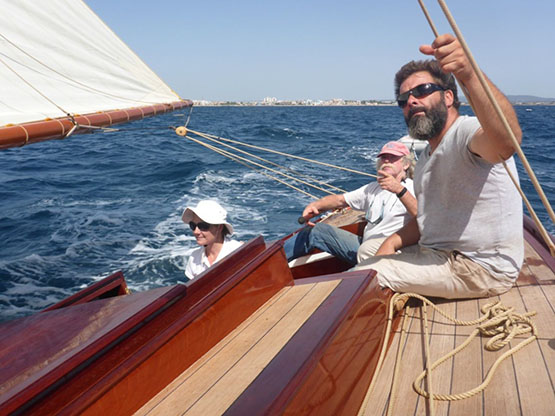
Aboard Tern on her first sail since restoration, off the coast of Mallorca in August
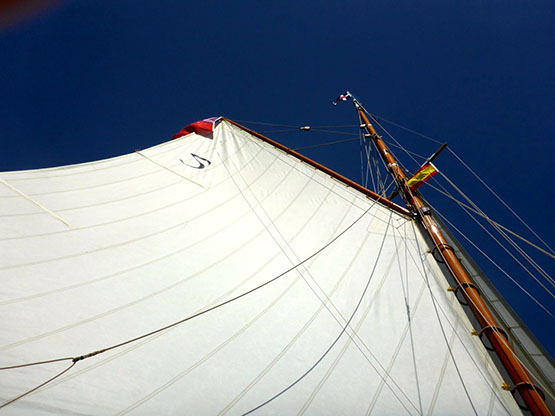 When the new Belfast Lough ODs started racing in May 1897, it all happened so quickly that when sailmakers Ratsey & Lapthorne at their Scottish loft found that they lacked Tern’s allocated sail number 7, shortage of time meant they simply used an inverted 2 instead, and this has been faithfully replicated in the new 2015 sails, also made by Ratsey & Lapthorne.
When the new Belfast Lough ODs started racing in May 1897, it all happened so quickly that when sailmakers Ratsey & Lapthorne at their Scottish loft found that they lacked Tern’s allocated sail number 7, shortage of time meant they simply used an inverted 2 instead, and this has been faithfully replicated in the new 2015 sails, also made by Ratsey & Lapthorne.
As well, the hull lines of the BLOD 25s from 1897 were then used for the building of the Dublin Bay 25s from 1898 onwards, though the Dublin Bay boats had a higher specification, and carried a lead ballast keel instead of the Belfast Lough boats’ less expensive cast iron.

One of the famous William Maguire Dublin Bay models in the National Yacht Club is of the Fife-designed Dublin Bay 25ft OD, whose hull lines were identical to Tern. And Tern herself - though by that time rigged as a cruising yawl - was based at the National YC from 1944 to 1954, firstly under the joint ownership of Charles E Hogg and Maurice Healy from 1944 to 1949, and then under the ownership of J J Lenihan until 1954, after which she moved to Falmouth in southwest England. Photo: W M Nixon
Kinsale Yacht Club Launches One Design Keelboat Regatta
#kinsale – The May bank holiday event saw the inaugural 'Axiom sponsored One Design keelboat Regatta' held in Kinsale YC. Twelve Squibs and five Dragons came out to do battle for the very generous prizes and newly commissioned trophy.
PRO Tony Ireson and his team provided great racing with 6 races held over the two days on a windward leeward course. Saturdays racing was held in 12-18 knots from the south west with the opening races in Dragons been taken by Little fella sailed by Cameron Good/Simon Furney and Henry Kingston.
The Squibs were having a fierce battle with places at the top constantly been swapped with National Champion James Mathews in Mucky Duck, Colm Dunne and Rob Gill in Allegro and Finbarr and Cian O'Regan in Fagin. Kevin Downey knocked in a great day with 4, 4, 5 in his new squib Grey Matter.
Day two saw the wind blowing from due south so Tony Ireson set his line at the mouth of the harbour. Lumpy seas and slightly lighter winds made for difficult sailing but Colm Dunne and Cameron Good found the groove and extended their leads with both finishing as overall winners.
At the prize giving there was great excitement as to which boat would win the newly commissioned trophy and after the criteria was spelt out by sailing secretary John Stallard the first name to go on the trophy is Allegro sailed by Colm Dunne and Rob Gill.
Such was the success of the event club Commodore Finbarr O' Regan was able to announce that Axiom Private Clients are to come on board for 2015 as the main sponsor and the dates were announced as May 2nd &3rd 2015.
Big Task Ahead for Small Boat Forum as Data Shows 'Sport on its Knees'
#smallboatforum – In anticipation of the small boat forum to be hosted next Saturday morning in the National Yacht Club, Roger Bannon has tried to gather some information over the last 2 years on attendance at class championships for dinghies and small keelboats.
In Ireland we have about 20 recognised small boat and dinghy classes made up of single handed, 2 handed and 3 handed boats.
Based on the data I looked at, approximately 700 boats participated in a National Championships with an average of 1,300 Irish competitors involved in 2012 and 2013.
The statistics make interesting reading;
33% were single handed boats
45% were two handed boats
22% were three handed keel boats and large dinghies.
The number of active participants was split as follows:
Single handed 18%
Two handed 47%
Three handed 35%
Assuming that most participants in singlehanded classes such as the Oppy, Topper and Laser Radial and 2 handed classes such as the Feva and Mirror are under 23 years of age, this group together with a few who were involved in other classes, made up about 40% of the total individuals involved.
The active pool of remaining older competitive sailors involved in small keel boats and dinghies is less than 800 individuals! Nearly 500 of them raced in Mermaids, SB20s Shannon One Designs, Squibs, National 18s and Flying Fifteens with less than 300 people sailing other more performance oriented classes.
Clearly this is not indicative of the numbers involved in club and other recreational small boat sailing activities but it is a very stark analysis of the current competitive situation for so called prestige events!
The harsh reality in Ireland is that we probably have fewer adults racing small boats competitively in recognised championships all year than sail on any Thursday evening in Dublin Bay Sailing Club!
Even if the figures are wrong by 50% the message remains materially the same. With exception of a small number of established classes, competitive small boat sailing in Ireland is clearly on its knees.
How can we reasonably expect to produce world class sailors from this modest environment?
The scope of the challenge is awesome!
ISA Hosts Convention To Discuss Dinghy Racing's Future
#ISA - The Irish Sailing Association has issued an open invitation to dinghy sailors to discuss the future of dinghy and one design racing in Ireland at a special meeting less than two weeks away.
The Dinghy & One Design Keelboats Convention will take place on Saturday 2 November at 10.15am in the JB Room at the National Yacht Club in Dun Laoghaire.
Chaired by Margaret O'Donnell, the convention follows on from the classes forum this past March, which led the ISA Board to establish a Dinghy/One Design Racing Advisory Group.
That meeting also prompted Ric Morris' suggestions for five things the ISA could do to rejuvenate dinghy sailing in Ireland. His salient points will surely provide much fodder for discussion on the day.
Do Ireland's One Design Sailing Classes Need A 2014 Pop–Up Regatta?
#onedesignsailing – Pop-up shops, pop-up restaurants – they're everywhere. Or if they're not exactly everywhere, at least we've seen enough of them to know that the idea has a certain appeal when traditional ways of doing business have suffered in recession, with out-of-town multiples knocking the traditional retail trade for six.
So who's on for a pop-up regatta? As we slip into the Autumn leagues and look back on one of the best and busiest Irish sailing seasons in years, it only serves to emphasise the fact that the programme for next year is so quiet as to be almost invisible.
Oh for sure it's a Round Ireland Year, and with the late-June circuit from Wicklow having added status through its extra points for the RORC Championship, we're probably going to be seeing something even more high powered than last time round in 2012.
And there'll be Cork Week in July too. The gallant Corkmen swung with the punches back in 2012. When they realised that their sailing megafest of the boom years was going to be recession-shrunk and then some, the notion of describing it as "small-but-perfectly-formed" did the business until some genius came up with the concept of the Boutique Regatta, which seemed such an attractive idea – and it gave great racing – that maybe they'll air it again for next year.
As for the ICRA Nationals, they're scheduled for the Royal Irish YC in Dun Laoghaire from 12th to 15th June. It's a star venue with the club's prime position on Ireland's biggest marina, while the immediate access to a large fleet in an area where cruiser-racing is a significant part of life afloat virtually guarantees the event's success. As a bonus, the fact that the Round Ireland starts a week later makes for a very attractive proposition for visiting boats who might like to get a lot of quality racing under their keels before June is out.
On the cruising front, the Irish Cruising Club will be celebrating its 85th birthday with a week long Cruise-in-Company in West Cork in early July, culminating in a grand finale at Glengarriff on July 13th, which is exactly 85 years to the day since this unique club came into existence. They're limiting numbers to 85 boats, but with the invitation extended to associated cruising clubs overseas, it could well be that this impressive total will be reached.
So perhaps it's an exaggeration to talk of next year's programme as being empty. But it's certainly sparse compared to 2013's seemingly endless and brilliant tableau, which included three world championships with the Mirror Worlds on Lough Derg, the J24 Worlds at Howth, and the International Association For Disabled Sailing Worlds at Kinsale. There were also the well-attended Volvo Dun Laoghaire regatta, and the rolling celebrations of the Old Gaffer's Association Golden Jubilee which brought classic and traditional boats to Dublin and Belfast. Glandore Classic Regatta followed soon after, while offshore the biennial Dun Laoghaire-Dingle Race had brought boats to the Kerry coast for the storm-harried yet successful ICRA Nationals, followed soon after by the Sovereigns Cup in Kinsale. As for dinghies, while some classes faltered, the huge turnout for the Laser Europeans at the National YC this month emphasised the enduring appeal and popularity of Bruce Kirby's timeless gem of a design.

A highlight of 2013 was the visit to Glandore Classics by the legendary Centenarian Jolie Brise, winner of the first Fastnet Race in 1925. Photo: Anthony O'Leary
It really has been a vintage year. But by and large, where the more prominent events featured racing, it was cruiser-racing which was dominant. And Ireland's enthusiasm for this branch of sailing received something of an international boost recently with the RORC measurement office praising the way in which we have successfully combined full-on IRC competition with the less extreme rating system provided by ECHO.
But it may well be that the unique situation of Dublin is the key to all this. The relatively limited weekend cruising options in the Dublin Bay area, and the fact that so many sailing folk live within a few minutes of their boat's berth, means that on a Saturday afternoon, and even more so on a Thursday evening, Dublin Bay SC is mustering impressively large fleets of cruiser-racers including many boat types which - in any other area - would not be thought of at all in the racing context. Yet DBSC can offer this attractive package of guaranteed sport in a very manageable time and travel package.

The multi-tasker. The First 31.7 is a thriving Dun Laoghaire One Design Class which provides cruising comfort with sailing speed. Photo: David O'Brien
Anyone who thinks that racing a comfortable cruiser is not really sport at all is much mistaken. There's a special challenge to it – getting the best possible performance out of a boat which provides genuine liveaboard amenities is extremely satisfying. And in the Dublin context of sociable sailing, there are many who pop down to Dun Laoghaire harbour for the convenient promise of a race sailing with friends, people who might not otherwise sail at all.
And they certainly wouldn't dream of having a small boat of their own, and racing in a one design class. The hassle and the discomfort, not to mention the extra physical demands and expense, can make for a very unfavourable comparison with crewing on a cruiser where able and congenial crewmembers are always welcome.
But one design racing is an equally valid form of our sport, and in compiling a list of boats which can provide one design sport in Ireland, we were astonished to find the figure hitting the 39 mark. As for the variety of boat types, eclectic only begins to describe it.
ONE DESIGN SAILING CLASSES RACED IN IRELAND
Ballyholme Bay
Cork Harbour OD
Dragons
Etchells 22
Ette
Fairies
Fireball
First 31.7
First 211
Flying Fifteen
Glen
GP 14
Howth Seventeen
Heir Island 24
IDRA 14
J24
J80
Laser
Mermaid
Mirror
National 18
OK Dinghy
Optimist
Puppeteer 22
Rivers
RS Elite
RS Feva
RS 200
RS 400
Ruffian 23
SB 20
Shannon OD
Shipman 28
Sigma 33
Squib
Topper
Water Wags
Waverley
Wayfarer
420
Most will be familiar, but some are gloriously unknown. The Ballyholme Bay, for instance, is a 21.75ft cabin sloop from around 1936, built in Scotland. Over the years the original nine boats were depleted by storm damage in their home anchorage, but there are still some around and the word is three are currently afloat and lining up for Ballyholme YC's traditional end-of-season pursuit race this Saturday for the Lufra Cup.

Ballyholme Bay Class in their prime on their home waters. Photo: W M Nixon
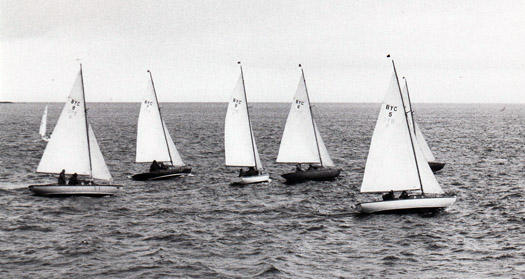
Originally there were nine boats in the Ballyholme Bay class, but numbers were gradually depleted as boats were wrecked in onshore gales on their exposed anchorage. Photo: W M Nixon

The Cork Harbour One Design Maureen. Designed by Fife, they're Ireland's senior keelboat class, as they date from 1895-96. Photo: Bob Bateman
The Ette class are clinker-built dinghies based in Castletownshend, so named because all their names end in "ette". As for the Heir Island 24s, they're also found around West Cork, built of GRP and with their design inspiration drawn from both the North Wales Seabird Half Raters, and the traditional Heir Island yawls.
The Fairy Class of 1902 onwards is found both on Belfast Lough and Lough Erne, and this summer while sailing through the RNIYC anchorage at Cultra, it was intriguing to compare them with the relatively new boats of the RS Elite class, which is in its turn a very miniaturised derivative of the last America's Cup keelboat class.
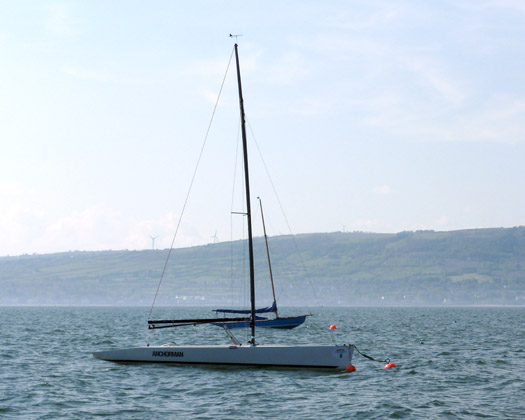
The old and the new – an RS Elite and one of the venerable Fairy Class in the RNIYC anchorage at Cultra on Belfast Lough. Photo: W M Nixon
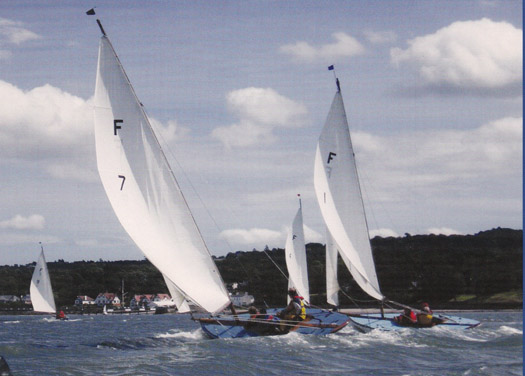
Fairy Class boats storming towards the finish line at RNIYC. The Belfast Lough boats changed to Bermuda rig many years ago........
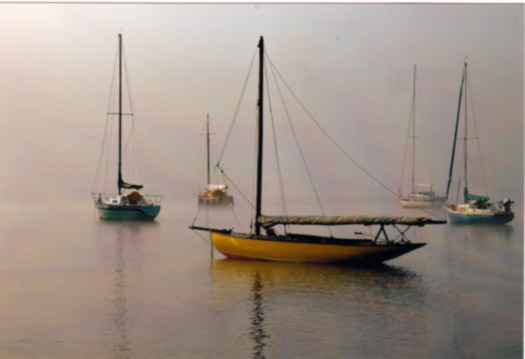
....but their sister-ships on Lough Erne have stayed with the original gunter rig.
The Flying Fifteens hold sway at several centres, but it's interesting to note that in Dun Laoghaire they buck the trend of being spread across all the waterfront club, as the FFers are exclusively sailors from the National YC. This may be one way to hold a class together against the many temptations to move to new boats that Dun Laoghaire offers, but another way of sustaining a class is to have it based on a peninsula of land or water.
A water peninsula? Well, how else would you describe Strangford Lough? Not only is it connected to the rest of the sea by a thin isthmus of water, but these Narrows are so tide-riven that Strangford Lough exists in a state of splendid isolation in which eccentricity thrives, and local ways of doing things hold sway.
Thus two local one design keelboats are dominant. The 25ft Mylne-designed Glens may have a sister class in Dun Laoghaire, and a couple of the boats may have ventured out of the Lough to go to the Mylne regatta in the Clyde a few years back, but their more senior cousins, the 29ft Rivers of 1919 vintage, haven't deigned to leave Strangford Lough since 1951, when they sallied forth to Belfast Lough for the Festival of Britain Regatta Week.

Kenny Smyth of Whiterock Boatyard with his beautifully-restored River Class Laragh, which he'd rescued abandoned in a field. Photo: W M Nixon
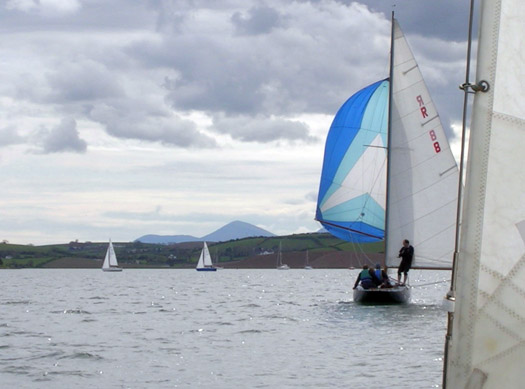
Kenny Smyth's Laragh in her usual position at the front of the River fleet on Strangford Lough, with the Mountains of Mourne in the distance beyond the classic County Down farmland. Photo: John Wichell
The dozen or so Rivers (nobody knows what happened to Number 4) have been saved from terminal decline by occasional bursts of fresh enthusiasm, one of the key movers being Kenny Smyth of Whiterock Boatyard, who found Laragh in a field in a state of dilapidation. He made such a lovely job of restoring her that the class revived, a recent recruit to the ranks of the owners being Brian Law, better known for his offshore racing feats in the trimaran Downtown Flyer. But despite other talents in the class, Kenny Smyth is still the man to beat, and they've had a good year in 2013, with ten of these interesting veterans making the start line.
But the likelihood of any River class boat ever leaving Strangford Lough to attend a regatta elsewhere is unlikely, and they're so absorbed in their own contented competition that it's unlikely they'd wish to inspire their home club of Strangford Lough YC at Whiterock to host a come-all-ye regatta for several one design classes.
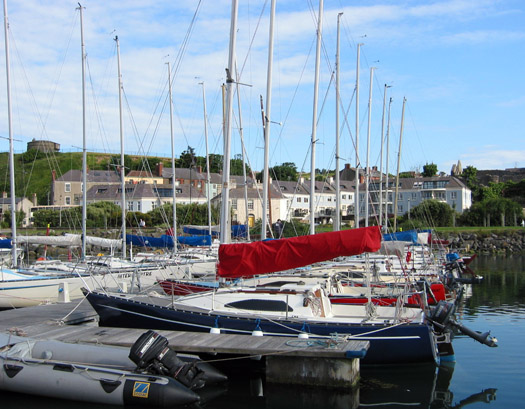
The Puppeteer 22s in their special berths in Howth Marina. The other leading local one design, the Howth 17, was designed by Herbert Boyd in 1897 in Howth House, the granite building at centre of photo. Photo: W M Nixon
So really it comes down to Dun Laoghaire if any venue is going to host a pop-up one design regatta next year. They already have half a dozen classes within the harbour, they invented the one design concept in 1887 with the original Water Wags, and it shouldn't be too difficult to entice the two significant one designs across the bay from Howth, the land peninsula which is another OD stronghold.
The Puppeteer 22s and the Howth Seventeens both draw their strength from the peninsula's vibrant sense of community. But both classes have been known to venture forth from time to time, with 15 of the Howth 17s managing to get to Glandore Classics back in 2003.
This past summer, two of them went even further afield, with the 2013 champion, the syndicate-owned Deilginis, and Ian Malcolm's 1898-built Aura, being road-trailed to the Classic One Designs Regatta in Cowes. In terms of numbers, the event was of course dominated by the Solent Sunbeams and the famous X One Designs, but the two little boats from Ireland carried their jackyard topsails with notable style, and Aura won the gaff-rigged class.
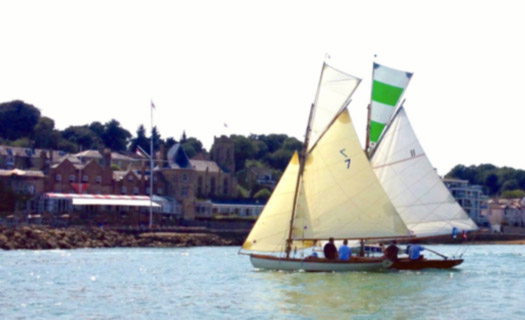
There's posh for you! The Howth 17s Aura and Deilginis strut their stuff off the Royal Yacht Squadron castle at Cowes during the Classic One Designs Regatta in July. Photo: Judith Malcolm
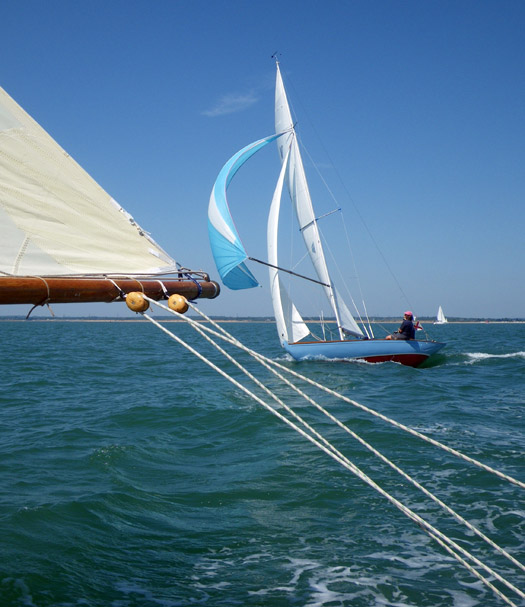
The sport is enhanced when other One Designs are about. A Solent Sunbeam seen from the Howth 17 Aura during the Classics at Cowes. Photo: Judith Malcolm
Yet the Howth Seventeens are just one class among many within easy reach of Dun Laoghaire harbour. But although next year's programme of major events doesn't look at all crowded, the dates will soon be filled. So anyone with the notion of a one designs special regatta should make it pop up soonest.
VOR Sail Wardrobe For New One Design Unveiled
#VOR - North Sails has revealed its sail wardrobe for the new one design VOR 65 with less than 18 months to go before the latest Volvo Ocean Race sets sail.
As The Daily Sail reports, the sails will be manufactured at North Sails' Nevada base using its 3Di process in a range of deniers, except for the A3 and storm jib.
Sails will be constructed in batches to ensure the same mould is used for eight sails of one type. The sails will then be finished at Vannes in France before being paired up with their respective vessels, assembly of which is racing ahead.
Perhaps most importantly, each team competing will have the use of just 12 sails - only eight of which will be allowed on board for each leg of the race. No recuts will be allowed except for repairs, in order to maintain the fairness of the one design principle.
“Our main objective is to make a really durable sail that holds its shape and stays together for as long as the race needs it to stay together," said North Sails general manager Jeff Neri.
The Daily Sail has more on the story HERE.
#VOR - The Volvo Ocean Race team caught up with Ireland's own Damian Foxall on board Sidney Gavignet's MOF 70 yacht Oman Sail with fellow VOR veteran Neal McDonald.
As reported in March on Afloat.ie, Ireland's top offshore sailor - and watch-leader for last year's VOR-winning team Groupama - is part of an international crew that attempted to break the Round Ireland speed record that was unfortunately abandoned due to the harsh wintry conditions.
But Foxall vowed that a repeat attempt is on the cards, and tells the VOR website that his experience on Oman Sail "is exactly what I wanted to do after the Volvo. I just wanted to sail with a smaller team of friends, racing with a good crew."
He added: "Sidney, Neal and I have been sailing and working a lot together. It’s a very natural thing and it’s a pleasure.”
Foxall also sings the praises of the MOD 70 one design, heralding the future of the Volvo Ocean Race and the new VOR 65 yacht.
"It’s light in terms of logistics and repairs. On the water too, I’m looking forward to enjoy the best of the One Design sailing – the battle on the water and not in the boatyard."
Laser Designer Launches Iconic Boat Under New Name
#Laser - The sailing world has been taken by surprise with the news that the designer of the Laser has launched his iconic design under a whole new brand amid allegations over royalty payments.
Bruce Kirby - whose single-handed one-design has become a staple at the Olympic Games - has apparently signed all new builder agreements to manufacture his rechristened Kirby Torch design, after terminating his previous deals at the end the last year.
"The issue is supply of the Kirby sailboat and parts to sailors worldwide," according to the Kirby Torch website. "After numerous attempts, Bruce Kirby felt he had no choice but to withdraw Laser brand building rights in North America and Europe."
It's alleged that lack of royalty payments for the design by at least one top manufacturer prompted the move by Kirby to strike out on own, but nothing has been confirmed as of this time.
It is also not known exactly what the consequences will be for currently sailed Lasers and for the International Laser Class Association (ILCA), although the Kirby Torch website states that all ISAF-plaqued Lasers are class legal under the renamed fleet.
More on this story as it develops...
































